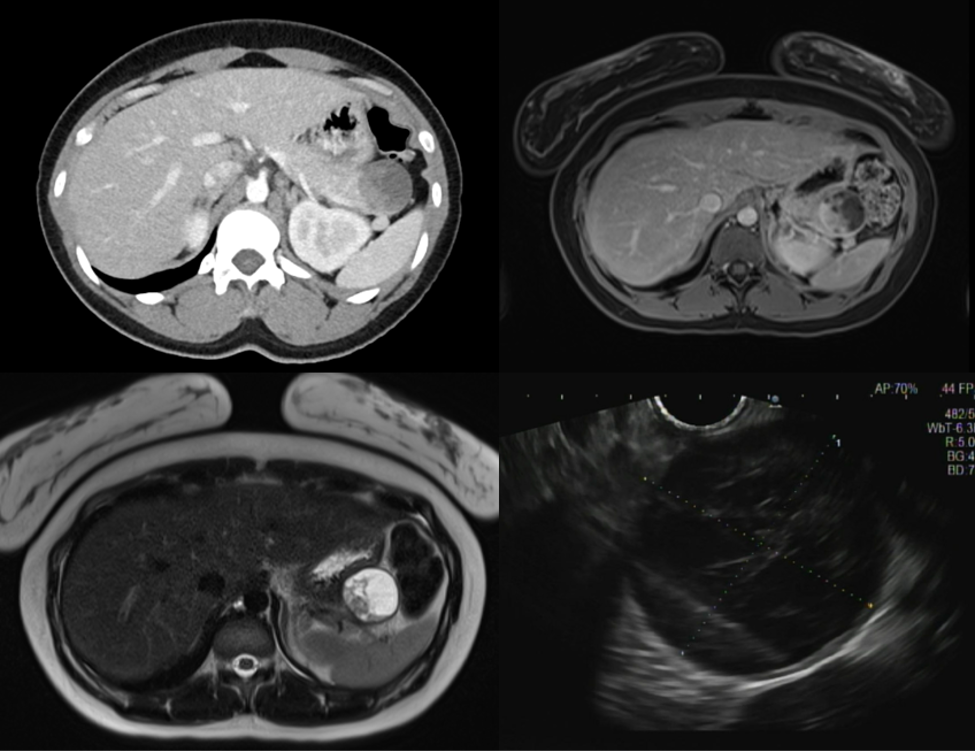Monday Poster Session
Category: Biliary/Pancreas
P2299 - Solid Pseudopapillary Neoplasm of the Pancreas Masquerading as Irritable Bowel Syndrome
Monday, October 27, 2025
10:30 AM - 4:00 PM PDT
Location: Exhibit Hall

Zoilo K. Suarez, MD (he/him/his)
University of Arizona
Chandler, AZ
Presenting Author(s)
Zoilo K.. Suarez, MD1, Lucas Hernandez, MD2, David G. Forcione, MD3
1University of Arizona, Chandler, AZ; 2University of Cincinnati, Cincinnati, OH; 3Boca Raton Regional Hospital, Boca Raton, FL
Introduction: Solid pseudopapillary neoplasm (SPN) of the pancreas is a rare malignant tumor that represents less than 3% of all pancreatic neoplasms. We present a case of a 24-year-old female with persistent atypical abdominal symptoms found to have SPN.
Case Description/
Methods: A 24-year-old female presented to our ED with abdominal pain in her left upper quadrant radiating to the back. She reported a two-year history of intermittent pain accompanied by bloating, constipation, and diarrhea, previously attributed to irritable bowel syndrome (IBS). An outpatient CT scan identified a 3.5 cm complex cystic lesion in the pancreatic tail. Subsequent MRCP further characterized the lesion as a 3.5 × 3.7 cm T2 hyperintense, T1 hypointense, heterogeneously enhancing cystic mass with nodular enhancing components abutting the adjacent stomach and causing a mild mass effect.
Endoscopic ultrasound (EUS) revealed a complex 3.7 cm cystic lesion in the tail of the pancreas, adjacent to the spleen, without evidence of ductal obstruction. Using Doppler guidance, a 19-gauge needle was used to aspirate blood-tinged fluid and cyst wall cells for diagnostic analysis. Fluid analysis showed a carcinoembryonic antigen (CEA) level of 1.3 ng/mL, amylase of 118 U/L, and glucose of 66 mg/dL. PancraGEN testing indicated benign features. Cytology demonstrated papillary cell proliferation with relatively uniform nuclei and fibrovascular cores. Immunostaining was positive for pancytokeratin (partial), CD10, progesterone receptor (PR), and CD56, with occasional intracytoplasmic PAS-positive globules consistent with a solid pseudopapillary neoplasm of the pancreas. Ultimately, she underwent a laparoscopic distal pancreatectomy with splenectomy.
Discussion: SPN are rare malignant tumors that mainly affect young women. Although often asymptomatic, they may present with nonspecific symptoms, posing a diagnostic challenge. In our case, the patient’s initial symptoms mimicked IBS.
Even though SPN generally have a low metastatic potential, a minority may exhibit aggressive behavior, underlining the importance of early surgical resection, which is associated with a good prognosis. This case highlights the importance of maintaining a broad differential diagnosis for persistent and/or atypical abdominal symptoms in young women, even when initial findings suggest a functional etiology, as earlier recognition is critical to ensure timely treatment.

Figure: Figure 1. MRCP and EUS.
Disclosures:
Zoilo Suarez indicated no relevant financial relationships.
Lucas Hernandez indicated no relevant financial relationships.
David Forcione indicated no relevant financial relationships.
Zoilo K.. Suarez, MD1, Lucas Hernandez, MD2, David G. Forcione, MD3. P2299 - Solid Pseudopapillary Neoplasm of the Pancreas Masquerading as Irritable Bowel Syndrome, ACG 2025 Annual Scientific Meeting Abstracts. Phoenix, AZ: American College of Gastroenterology.
1University of Arizona, Chandler, AZ; 2University of Cincinnati, Cincinnati, OH; 3Boca Raton Regional Hospital, Boca Raton, FL
Introduction: Solid pseudopapillary neoplasm (SPN) of the pancreas is a rare malignant tumor that represents less than 3% of all pancreatic neoplasms. We present a case of a 24-year-old female with persistent atypical abdominal symptoms found to have SPN.
Case Description/
Methods: A 24-year-old female presented to our ED with abdominal pain in her left upper quadrant radiating to the back. She reported a two-year history of intermittent pain accompanied by bloating, constipation, and diarrhea, previously attributed to irritable bowel syndrome (IBS). An outpatient CT scan identified a 3.5 cm complex cystic lesion in the pancreatic tail. Subsequent MRCP further characterized the lesion as a 3.5 × 3.7 cm T2 hyperintense, T1 hypointense, heterogeneously enhancing cystic mass with nodular enhancing components abutting the adjacent stomach and causing a mild mass effect.
Endoscopic ultrasound (EUS) revealed a complex 3.7 cm cystic lesion in the tail of the pancreas, adjacent to the spleen, without evidence of ductal obstruction. Using Doppler guidance, a 19-gauge needle was used to aspirate blood-tinged fluid and cyst wall cells for diagnostic analysis. Fluid analysis showed a carcinoembryonic antigen (CEA) level of 1.3 ng/mL, amylase of 118 U/L, and glucose of 66 mg/dL. PancraGEN testing indicated benign features. Cytology demonstrated papillary cell proliferation with relatively uniform nuclei and fibrovascular cores. Immunostaining was positive for pancytokeratin (partial), CD10, progesterone receptor (PR), and CD56, with occasional intracytoplasmic PAS-positive globules consistent with a solid pseudopapillary neoplasm of the pancreas. Ultimately, she underwent a laparoscopic distal pancreatectomy with splenectomy.
Discussion: SPN are rare malignant tumors that mainly affect young women. Although often asymptomatic, they may present with nonspecific symptoms, posing a diagnostic challenge. In our case, the patient’s initial symptoms mimicked IBS.
Even though SPN generally have a low metastatic potential, a minority may exhibit aggressive behavior, underlining the importance of early surgical resection, which is associated with a good prognosis. This case highlights the importance of maintaining a broad differential diagnosis for persistent and/or atypical abdominal symptoms in young women, even when initial findings suggest a functional etiology, as earlier recognition is critical to ensure timely treatment.

Figure: Figure 1. MRCP and EUS.
Disclosures:
Zoilo Suarez indicated no relevant financial relationships.
Lucas Hernandez indicated no relevant financial relationships.
David Forcione indicated no relevant financial relationships.
Zoilo K.. Suarez, MD1, Lucas Hernandez, MD2, David G. Forcione, MD3. P2299 - Solid Pseudopapillary Neoplasm of the Pancreas Masquerading as Irritable Bowel Syndrome, ACG 2025 Annual Scientific Meeting Abstracts. Phoenix, AZ: American College of Gastroenterology.
